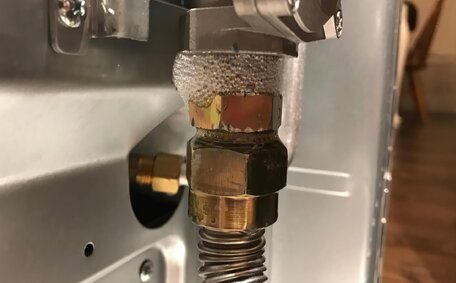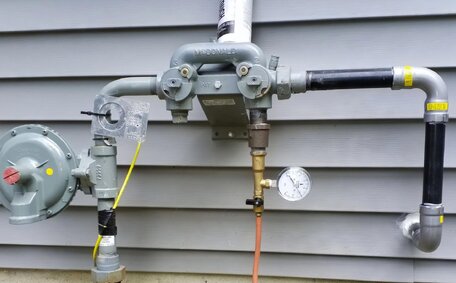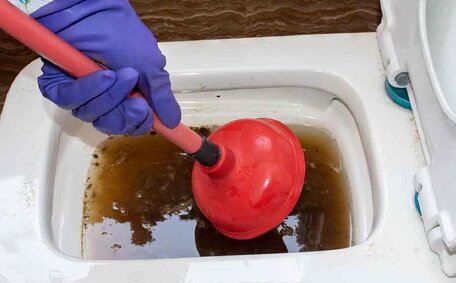Understanding Freezing Points in Plumbing Systems
Your pipes typically risk freezing at 32°F (0°C). At this critical temperature of 0°C, water’s transformation into ice, which causes a 9% volume increase, generates pressure within pipes that can provoke bursting if the freeze sustains.
To circumvent pipes freezing, maintain your indoor temperature at a minimum of 13°C, as lower temperatures heighten the risk of ice formation within the pipes. Insulating pipes, sealing air leaks that allow cold air entry, and keeping faucets dripping to maintain water flow can help prevent ice expansion within pipes.
Addressing pipe freezing starts with understanding water’s freezing point, enabling homeowners to undertake precautions like maintaining regulated indoor temperatures to lessen the likelihood of bursting pipes.
Key Factors That Contribute to Frozen Pipes
There are several key factors that make pipes more prone to freezing:
- Insufficient insulation - Pipes that lack adequate insulation are at high risk of freezing, especially if they are located on exterior walls or in unheated spaces like attics or crawl spaces.
- Air leaks allowing cold air inside - Any cracks, gaps or openings that let cold outdoor air into your home can quickly chill pipes to below freezing.
- Pipe materials - Plastic and copper pipes are more prone to burst under freezing conditions, unlike stronger materials such as PEX or CPVC.
- Shutting off heat to vacant areas - Turning down the thermostat or shutting off vents in unused rooms increases chances as water can freeze more readily in lower temperatures.
- Draughty windows or doors - Poor seals result in cold drafts that can quickly freeze nearby pipes.
- Sub-freezing outdoor temperatures - Prolonged exposure to outdoor air at 32°F (0°C) or below can cause pipes to freeze.
Taking preventative measures such as insulating your pipes, sealing drafts, servicing windows and doors, and keeping indoor heating sufficient is key to stop your pipes from freezing and resulting in burst pipes.
Pipe Location and Risks
Certain areas and types of water pipes freezing in a home are more prone to freezing than others:
- Pipes positioned against exterior walls or those within outer walls with limited insulation are at high risk because cold air readily enters your home, impacting such pipes.
- Pipes in unheated spaces such as attics, basements, and areas your home that are not regularly warmed are likely to freeze during winter as temperatures can plummet below freezing.
- Sections of pipe that run through cabinets on your walls near water sources and that are exterior are more vulnerable because cold drafts enter through the cabinet.
- Pipes located under sinks just outside your property’s exterior walls with relatively little insulation separating them from the cold are more susceptible to freezing.
Why do pipes freeze? The risk begins when temperatures drop near 20°F (-6.67°C) and increases the colder it gets. Knowing the most freezing-prone pipe locations allows preventative measures to be focused where they are needed most to avoid burst pipes.
Insulation and Protection Strategies
To protect pipes from freezing temperatures, do when your preparations involve ensuring vulnerable areas are well-insulated. Closed cell pipe insulation made of foam rubber or fibreglass are recommended, with an R-value of at least R3. These insulation wraps, ideal for any vulnerable water pipe, can be purchased at local hardware stores like Bunnings Warehouse.
According to insulation experts, attics, basements and crawl spaces require extra precautions, a fact galeotafiore emphasised in a recent plumbing seminar about freezing risk management. Fibreglass batt insulation with an R13-R30 value, when placed on attic crawl space floors and walls, prevents cold air infiltration and keeps pipes warmer.
Sealing any openings, cracks or penetrations with caulk or spray foam is critical to prevent cold air into your residence from reaching pipes. Insulating HVAC ductwork running to unheated places also helps moderate temperatures.
In severe winter weather, supplemental safe heat sources such as UL-listed heat tape or cable wraps plugged into a GFCI protected circuit can further protect pipes from freezing.
How Pipes Burst When Frozen
The dreaded scenario of a frozen pipe can become reality when water expands as it transitions to ice. Water’s 9% expansion upon freezing escalates pressure within pipes, straining the walls to a point where they may crack and burst. This pressure within the pipe can cause the walls to crack and split open, leading to serious problems.
When a frozen pipe bursts, water surges from the afflicted area during thawing procedures. Burst pipes can lead to severe water leaks, causing rapid flooding in a building and inflicting water damage to floors, walls, and belongings. Additionally, the loss of water supply disrupts activities as it stops water around pipe systems from being accessible in your house.
The most prone areas for frozen pipe bursts include attics, crawl spaces, areas adjacent to your hose bib, and rooms with little to no insulation, especially where exposed pipes are present. Sections exposed to cold drafts or winter weather are also at high risk.
Preventing frozen pipes is crucial to avoid pipe bursts and subsequent water damage. Strategies like insulating pipes, sealing air leaks, and maintaining adequate indoor heating can help keep your pipes from dropping to dangerously low temperatures.
Thawing Frozen Pipes Safely
When attempting to how thaw frozen pipes, safety should be the top priority to avoid injury or further pipe damage. Follow these tips:
- To safely thaw a pipe, never use an open flame or blowtorch; instead, if unsure, call a licensed plumber for assistance. Such actions carry significant fire and explosion hazards, notably in pipe systems that may contain gas.
- Start thawing nearest to the faucet to allow the water drain process to begin freely, where cold water is most likely to freeze first. This approach allows for water drainage, even from frozen pipes, thereby reducing the likelihood of bursting.
- To thaw pipe areas, apply heat by using a UL-listed heat tape, heating pad, or portable space heater, directing moderate heat onto the frozen section. Do not overheat pipes.
- Alternatively, you can use hair dryer on its highest setting directed around the pipe at the frozen area, methodically moving along its length. Take care not to overheat any spot.
- Check different areas of the pipe repeatedly to know where the frozen area closest to the faucet is located. Thaw this section first.
- Turn on the faucet slightly to relieve water pressure as ice melts and water through pipe begins to flow again.
- Once there’s no water pent up, continue applying heat on the pipe for another 30 minutes before gradually removing the heat source and closing faucets.
- Contact a plumber immediately if you are unable to locate or thaw the frozen area, or if pipes have burst.
If you’re seeking advice and have worry about your pipes frozen and at risk of freezing, rely on indirect heat sources, work backwards from the faucet, and routinely monitor pipe pressures. If you’re not certain, it’s wiser to call a professional plumber who can see to the issue properly.
Dealing With Burst Pipes
What do frozen if you discover a burst pipe? Immediately locate and turn your main water shutoff valve to shut off water to your home. This is usually next to the water meter where your main water to the building can be shut off. Turning off water supply lines prevents flooding and additional water damage.
Have a look up our contact information, and reach out to Kenthurst Plumbing right away at 1300 349 338 or [email protected]. Our team of licensed plumbers can help prevent the flow of water, assess pipe damage, and make necessary repairs.
Addressing pipe bursts quickly is crucial to prevent mould growth and more severe structural damages. Our technicians will assess the damage in the same way, determining if sections of saturated drywall or insulation need to be cut out and replaced. We can also use water extraction equipment to remove standing water.
Kenthurst Plumbing offers round-the-clock emergency plumbing services, all detailed in our terms and conditions. Call us when pipes freeze or burst to minimise water damage risks. Our skilled team has the experience to resolve issues when frozen pipes burst and get the plumbing system of your property working again.
Preventative Measures
There are several effective preventative measures homeowners can take to avoid pipes freezing during cold weather:
- Maintain consistent thermostat temperatures to prevent frozen pipes in your home day and night. Avoid lowering temperatures at night, as a reduction of more than 5-10°F (-15 to -12°C) can make your pipes more vulnerable to freezing.
- Seal air leaks admitting cold drafts near water pipes, especially around the drain line. Use caulk or spray foam insulation to fill gaps.
- Leave cabinet doors open under kitchen bathroom sinks, where your taps are often located, on outside walls so warm air can reach those pipes.
- Keep your interior doors open to allow warm air circulation throughout, reducing the risk of freezing in lesser-used spaces.
- Take proactive steps to insulate your water pipes in unheated areas such as crawl spaces, basements, and attics.
- For outdoor hose bibs, turn off interior water supply valves and open spigots to drain residual water from the supply line before freezing temperatures arrive.
- Consider installing UL-listed heat tape or heating cable products to vulnerable water pipes if you experience recurring frozen pipes.
Grasping how to prevent frozen pipes can spare homeowners from expensive repairs and the water damage resultant from pipe bursts. Contact Kenthurst Plumbing at 1300 349 338 for professional help protecting your plumbing this winter, and to spruce up our your pipes’ safety.
Maintaining Warm Temperatures
To keep your home safe from the ravages of winter, it is crucial to maintain a consistently warm temperature to prevent frozen pipes. Set your thermostat to at least 55°F (13°C) during cold weather and avoid lowering it at night. Space heaters may be employed to elevate temperatures in uninsulated, freeze-susceptible zones such as attics and crawl spaces.
Check that your home’s heating system is well-maintained to ensure your pipes are protected and running efficiently before winter arrives. Clean or replace air filters as needed so your heating system doesn’t have to work as hard circulating air. Have a technician inspect your furnace, heat pump or boiler to ensure it’s in good working order.
Insulate areas like exterior walls, attics, basements and crawl spaces properly to retain heat better. Use caulk or spray foam sealant on cracks and gaps that allow cold air inside. This helps moderated temperatures around pipes.
Daily tracking of indoor and outdoor temperatures during a cold snap aids in evaluating the risk of pipes freezing. During extreme cold snaps, take additional measures such as opening cabinet doors to warm pipes with indoor air, letting taps drip gradually, or applying supplemental heat sources by vulnerable pipes.
Professional Tips for Frozen Pipes
With expertise in plumbing, do your pipes need inspection? Kenthurst Plumbing has been serving Sydney for over 10 years, handling frozen and burst scenarios. We recommend the following tips to help prevent pipe freezing issues:
- Get your plumbing system checked prior to winter to pinpoint pipes susceptible to freezing. We can provide professional advice on insulating prone areas.
- Install heat trace cable wrapped around pipe sections most susceptible to freezing. Heat trace warms pipes just enough to prevent ice buildup.
- Block any openings or gaps that admit cold drafts. Our technicians can find and seal problem areas during an inspection.
- Insulate water pipes in unheated spaces like attics, basements and crawl spaces. We use high quality insulation for maximum protection.
- Repair draughty windows and doors to stop cold air entering your home and reaching water pipes.
- Maintain consistent indoor temperatures near 20°C during winter, even when you are not home.
- Familiarise yourself with shutting off your water and draining pipes for extended absences in freeze-prone conditions.
Rely on the licensed professionals at Kenthurst Plumbing to safeguard your plumbing against freeze damage this winter. Contact us at 1300 349 338 to schedule an inspection or discuss customised frozen pipe solutions for your Sydney home.






